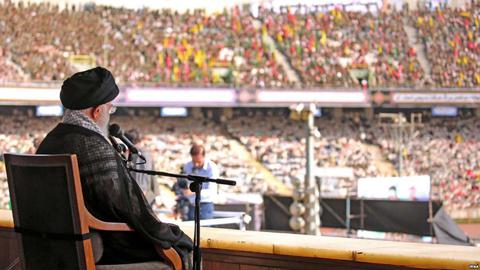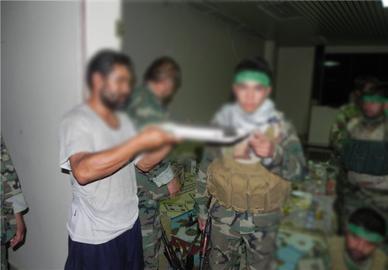During a speech in Tehran’s Azadi Stadium on October 4, Ayatollah Ali Khamenei vowed that the Iranian regime will overcome the economic and political pressure exerted by Donald Trump’s government. In his speech to a crowd of 70,000 Basij members, the Leader said as long as he was alive he would not accept any compromise with the United States. Iran’s official media outlets reported that all Iranian high-ranking military commanders and more than 100,000 members of the Basij, affiliated with the Revolutionary Guards and one of the largest paramilitary forces in the world, were present for his public address.
The content of Ayatollah Khamenei’s speech, the magnitude of the Azadi Stadium gathering and the staging of the October 4 event made headlines inside and outside Iran.
The event once again attracted the attention of domestic and international observers to the patterns of the Leader’s public appearances, and the way in which he communicates his messages to the supporters of the Islamic Republic.
The Leader’s Presence at Huge Gatherings
Huge gatherings such as that of October 4 are very occasional. In fact, from the beginning of Ayatollah Khamenei’s leadership in 1989, the Basij has organized less than a handful of meetings of this size in the presence of the Leader.
The last time the Basij arranged a somewhat similar meeting was on November 20, 2013, at the Grand Mosalla of Tehran, a place dedicated to al-Eid prayers ceremonies and, occasionally, to special Friday prayers events. Iranian state-run media outlets claimed that about 50,000 low and middle-level Basij commanders gathered to listen to the Leader’s speech.
On November 25, 2010, another gathering was held near the headquarters of the 27 Mohammad Rasoulollah Army (the Revolutionary Guards’ biggest provincial army), located in one of the capital’s suburbs. According to government media, about 110,000 Revolutionary Guards and Basij members and commanders took part.
On April 20, 2000, Ayatollah Khamenei addressed a meeting held by the Basij and the National Youth Organization at the Grand Mosalla of Tehran. Iranian official media reported that the audience was made up of tens of thousands of young people.
Throughout the years, the Leader has also addressed smaller gatherings to mark the occasion of the Basij Week (November 20 to 26). The events of November 21, 1993, November 26, 1997 and November 26, 2007, are examples of such assemblies.
It is not necessarily easy to identify a fixed pattern or set model for these occasions. However, the Leader has used all of these events to present a firm front against foreign and domestic “enemies” of the Islamic Republic. In each event, the Leader has emphasized his uncompromising position when it comes to both domestic and international arenas.
The Leader’s Trips
Ayatollah Khomeini, the founder of the Islamic Republic of Iran, was famous for his unique set of leadership traditions. One of these traditions was to avoid leaving his residence for any purpose, even to attend the gatherings of his supporters. In fact, after January 1980 (a year on from the victory of the revolution), he never left his residence. Instead, he received state officials and the masses of supporters at his residence.
His successor, Ayatollah Ali Khamenei, does not stay at his residence at all times, but he only leaves it for very specific occasions.
Although he ventures out further than his predecessor, since becoming the Leader of the Islamic Republic, Ayatollah Khamenei has not left Iran, although he makes occasional trips outside Tehran. One of his famous traditions is to make short trips to the holy city of Mashhad for the new Iranian year — except in the years 2002 and 2003. He didn’t go to the eastern Iranian city for unknown reasons these years, though some attributed it to exercising extra caution after the US invasion of Afghanistan, which took place not far away.
When in Mashhad, he often addresses thousands of people who gather in the holy shrine of the 8th Shia Imam to hear him speak.
Ali Khamenei also makes at least one (and sometimes two) short provincial trips to different areas of Iran on an annual basis. During these trips, Basij members, employees of state institutions, pupils and other locals are transported to large venues to listen to the Leader speak. During these trips, he also delivers a speech at the joint military ceremony of armed forces of the province, and participates in the working session of provincial and national executive officials.
In addition to these regular trips, he makes very occasional, unofficial trips to the holy city of Qom, where the shrine of the 8th Imam’s sister is located. During such trips, the Leader does not usually participate in big public gatherings; instead, he meets with a number (but not all of) Qom’s Grand Ayatollahs.
The Leader’s Presence in Events in the Capital
Every year, the Leader leaves his residence a number of times to take part in specific events in the capital.
Apart from very few cases where he participated in the huge gatherings organized by Basij members (such as in 2018, 2012, 2010 and 2000), he usually leads various Friday prayers ceremonies. In fact, until 2011, Ayatollah Khamenei led at least one (and sometimes two) Friday prayer ceremonies in the capital. But since 2011, he has not led any Friday prayers ceremonies in Tehran. There has been a range of speculations as to the reason for this change. Some observers have attributed it to his health, while others connect it to possible security concerns. On September 26, 2015, Sayed Reza Taghavi, the former head of the Friday Prayers Policymaking Council, suggested that the Leader had expressed an unwillingness to lead Friday Prayers because the security checks required if he did so would “disrupt the prayers.”
Beside the Friday Prayers, Ayatollah Khamenei always leads the special prayers for the Eid al-Fitr, which is held every year at the end of Ramadan (the month of fasting). This ceremony is always held in Tehran’s Grand Mosalla.
Tehran’s International Book Fair (held every year in May) is another example of the public events in which the Leader used to participate regularly, but the pattern has changed here too. For instance, since the beginning of Hassan Rouhani’s presidency, the Leader has not attended the book fairs in 2017, 2016 and 2014, although he did attend in 2018 and 2015. The Iranian conservative media have attributed the Leader’s attitude to his dissatisfaction with the Rouhani administration’s cultural policies.
The Supreme Leader also participates, on an annual basis, in at least one graduation ceremony for Revolutionary Guards or Artesh (the regular army) officers. The anniversary of Ayatollah Khomieni’s death, which is commemorated annually in the late Leader’s shrine, is another event Khamenei always attends. Prior to the new Iranian year (20 March), the Leader often goes to the famous Behesht-e Zahra cemetery, where many Iranian former officials, as well as thousands of Iran-Iraq war soldiers (regarded as martyrs) are buried. On the eve of the new year, on the occasion of Tree-planting Day, he also leaves his residence to take part in that particular national activity.
The Supreme Leader takes part in a number of occasional events, too. Among them are specific industrial and military fairs (especially those that demonstrate the latest military achievements of the armed forces), and a limited number of commemoration services hosted by high-ranking state officials.
The Leader’s Receptions
A great majority of Ayatollah Khamenei’s public appearances take place at his residence, a very big complex in the center of Tehran that includes several gathering places of different sizes.
Every year, groups of Iranian officials as well as selected members of state institutions travel to the complex to visit the Leader and hear him speak. In addition to such officials and employees, the Leader receives selective groups of citizens, too. For instance, he holds annual meetings with military and paramilitary personnel, poets, university students, religious singers (eulogizers), Koran reciters, teachers, and workers.
The Supreme Leader also has a tradition of receiving large numbers of state officials and other trusted citizens on certain religious occasions. Commemorations for the Shia first and third Imams (Ali and Hossein), as well as that of the Prophet’s daughter (Fatemeh) are examples of such public events held at the Leader’s residence.
During the month of Ramadan, Ayatollah Khamenei leads daily public prayers at his residence, in which state officials and a selected group of trusted citizens can participate. Participating in such daily prayers is regarded as a privilege for those individuals who are allowed or able to do so.
visit the accountability section
In this section of Iran Wire, you can contact the officials and launch your campaign for various problems

























comments